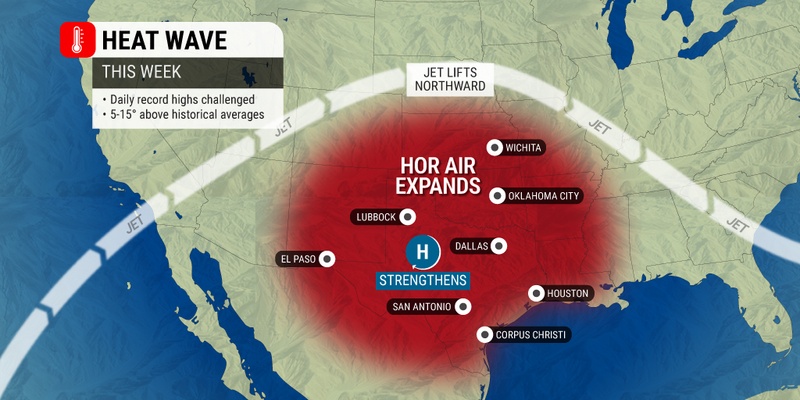
Heavy Rain, Flooding, and Chance of Severe Weather Staring Down the Southern U.S.
January 22, 2024
Posted: June 28, 2023 9:00 am





You are not in luck if you are hoping for relief from the record-breaking heat this week across much of the south-central U.S. The mercury began a steady climb last week with more heat on the way for the region in the coming days.
Here is a more detailed look at this deadly heat wave, including when you can expect to find some relief.
Texas has seen the worst of the heat in recent days with temperatures reaching well above 110 degrees in some areas of the state. The heat was blamed on two deaths last Friday in Big Bend National Park, located in southwest Texas near the Mexican border.
According to a press release from the National Park Service (NPS), a 31-year-old man and his 14-year-old stepson reportedly died while hiking the Marufo Vega Trail. The NPS said this part of the trail was experiencing temperatures of 119 degrees on Friday.
Forecasters warn that the all-time high temperature for the Lone Star State of 120 degrees may be in danger of falling this week. This is all coming after a week in which many cities saw readings in excess of 100 degrees for several days in a row.
For instance, the city of McAllen saw its first 100-degree day of the year on June 13 and it has not been lower than that for a high since that date.
The oppressive heat is the result of a northward bulge in the jet stream in the nation’s midsection. This bulge has allowed hot air from Mexico to move into New Mexico, Texas, and Oklahoma. Even the southern edge of Kansas has seen this extreme heat in recent days as a heat dome set up over the region.
While this part of the country is no stranger to this level of heat, it is happening earlier in the season than is typical. Dallas usually records its first 100-degree day around the 4th of July on average. However, the metroplex recorded this reading on Sunday when the temperature made it all the way to 101 degrees.

The real feel temperatures will reach even higher plateaus. When combined with the humidity and the sun, these readings could approach 115 degrees in a large swath of land stretching from Texas and to the Gulf Coast.
Unfortunately for Texas, heat that lingers this long puts a significant strain on the state’s power grid. The increased demand required by air conditioning units is largely to blame for this strain. ERCOT, the state’s energy provider, has already warned about the possibility of rolling blackouts in the days ahead.
This is a good time to think about those in your life that are most vulnerable to the heat and make a plan to check in on them periodically.
According to the U.S. Centers for Disease Control and Prevention (CDC), populations most likely to experience issues with the heat include the elderly, young children, outdoor workers, pregnant women, people with underlying health conditions, athletes, and those individuals living in low-income housing.
Forecasters are predicting that the heat dome will begin to dissipate over the weekend. However, temperatures are still expected to hover a few degrees above what is normal for the beginning of July. As the jet stream develops a southward dip over the central portions of the country, the heat will be pushed out of the area that has been dealing with this extreme weather.
You can expect temperatures to fall back into the 90s by Sunday for cities such as Dallas. More clouds and the chance of storms will also impact the area by the weekend, helping to nudge the mercury downward.
This relief will likely be short-lived. July and August typically bring the hottest temperatures of the year for Texas and the surrounding states. This means the worst may still be yet to come.
Did you find this content useful? Feel free to bookmark or to post to your timeline for reference later.

January 21, 2024

January 19, 2024

January 18, 2024